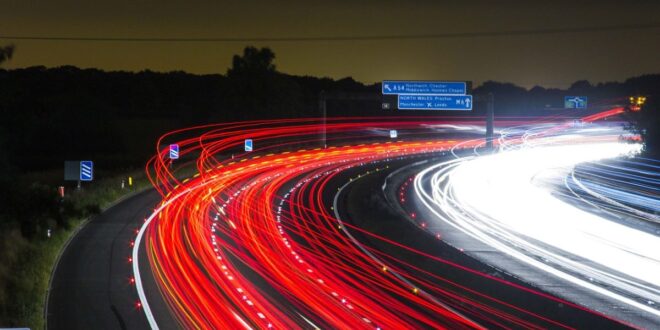Sometimes, in conversations or while driving, you may hear mentions of freeways, highways, and expressways. If you are curious, you may wonder why these names exist and how they differ from each other. So what is the difference between a freeway and a highway?
Highways are essentially regular roads expanded to allow more vehicles through them. You regularly enter highways through a traffic light or junction. A freeway is a larger version of highways, with more lanes and fewer access points to allow smoother traffic. You usually do not enter a freeway from traffic lights but on-off ramps.
This article discusses the differences between a freeway and a highway. Aside from that, we also look at how freeways and highways differ from expressways.
What Is A Freeway?
A freeway is a larger set of roads to facilitate a higher traffic volume. These roads often are found in big cities, as freeways help to connect the sprawling suburbs with the city center. It usually features at least four lanes and is not tolled usually. Freeways are usually entered through ramps.
As cities expand, the suburbs and new townships may become further away from the city center; resulting in commuting becoming a bigger challenge, especially if a person has to drive from the suburbs to the downtown office to work.
As a result, freeways are built. The major goal of a freeway is to allow a larger volume of traffic to travel at a higher speed. This allows the sprawling suburbs to remain connected to the city center, as the driving time is still low despite the distance.
Freeways are usually wider, with at least four lanes. There may also be wider road shoulders functioning as emergency lanes, giving drivers the confidence to drive faster. There may also be walls or fences on the roadside to prevent animals from entering the freeways.
You usually enter and exit freeways through ramps and no traffic lights. This ensures you join the freeway with your vehicle at a higher speed. As a result, freeways tend to have a higher speed limit. It is common to see freeways having around 70 to 80 MPH (112 to 128 KMH)
What Is A Highway?
Highways are roads with a higher speed limit than regular roads. It is usually broader, has wider shoulders, and may feature more than two lanes. Highways are usually accessed through traffic lights and junctions. Some highways may be tolled, although highways are mostly free.
Highways are essentially a smaller version of the freeway. While freeways may be more limited in their access, highways are more open, with more access points.
This is because the highway’s main role is to connect the roads it passes through between points A and B. It acts as the main thoroughfare for the smaller roads.
It is built to accommodate larger traffic but slower-moving ones. The roads may be two lanes or more, depending on the traffic. The road shoulders may be wider, acting as emergency lanes and allowing drivers more confidence while driving.
Highways tend to have lower speed limits, at around 55 to 70 MPH (88 to 112KMH). This is because many vehicles may join the highway at a lower speed, such as from T junctions or traffic lights.
Some highways may be tolled, while some don’t. This may point back to the way the highways are managed or built. Some highways were built by private companies. This means fees are collected from the users to pay for highway maintenance.
What Is The Difference Between A Freeway And A Highway?
A highway and freeway may differ in many ways: lanes, access, exits, speed limit, build standards, and signs and signals. They also may be built for different needs, and may serve different stages of urban development.
| Aspects | Highway | Freeway |
| Lanes | Minimum of two | Minimum of four |
| Entries and Exits | Traffic lights, junctions, crossroads | Ramps |
| Build Standards | Lower | Higher |
| Signs And Signals | More | Less |
| Speed Limit | Lower | Higher |
Generally, for urban development, you first see roads before highways and, eventually, freeways. This is because these motorways are built for different needs and may serve their use at different stages of urban development.
Lanes
Generally, highways tend to have at least two lanes. However, the lanes may be wider and feature wide shoulders as well. Freeways usually start with more lanes, with a minimum of four. The lanes are also wide, with wide shoulders, similar to highways.
However, freeways usually have fences or walls on the side of the road to prevent people or animals from entering the freeway. Highways generally do not have this.
Entries and Exits
You usually enter or exit a highway from crosswords, T-junctions, or traffic lights. This is because highways usually serve as the major artery connectors between the smaller roads in a particular area.
With freeways, you tend to enter or exit from ramps. This is because freeways tend to have faster-moving vehicles than highways, so you need to join the freeway with your vehicle at a higher speed. A ramp gives you the time and distance to speed up before joining the freeways.
Speed Limit
Highways tend to have a slower speed limit than freeways. The speed limit for highways is around 55 to 70 MPH (88 to 112KMH). For freeways, you will probably be asked to drive around 70 to 80 MPH (112 to 128 KMH).
The difference in speed limit may indicate that both motorways serve different purposes. Highways connect smaller roads which means many cars may join the road from junctions and traffic lights. As a result, the driving conditions are messier, which means a slower speed is required.
Freeways connect sprawling urban areas with each other, meaning the goal is to encourage drivers to drive at a higher speed as they commute. As a result, the speed limit is higher on freeways.
You may like this article: Difference Between Village And Town
Build Standards
Generally, you may assume that freeways have higher build standards than highways. This is because freeways are built to encourage drivers to drive at a higher speed to travel within the urban area.
As such, many freeway standards are built to give drivers the confidence to do so. There are more lanes, and the opposing traffic flow may be separated by a wall, ditch, or dividers. The roadside may have wider shoulders, and the roadside may also have walls or fences to prevent animals or people from entering the freeway.
Standards for highways tend to be less strict. Highways tend to handle slower speeds and cannot accommodate as many cars.
Signs and Signals
You may see more signs on highways than on freeways. This is because highways tend to be messier to navigate than expressways. This means motorists must be reminded much more while driving on highways.
For example, highways are not fenced, meaning animals or people may cross the road. Highways also may have a lot of traffic stops, as well as junctions to enter other roads as well.
There is no need to have signs for animals, crossroads, or traffic lights on freeways since freeways are built to eliminate these. On top of that, freeways tend to have fewer entry and exit points compared to highways.
Are Expressways Similar To Highways?
Expressways are not highways; they are motorways built to a much higher standard to accommodate even larger traffic and speed limits. Expressways are also built to accommodate larger vehicles and are usually tolled.
The development of a motorway may start with a simple two-lane road. As traffic increases, the road is widened and turned into a highway. The highway may be upgraded into a freeway when the traffic and distance grow further.
The next stage of motorway development would be to build an expressway. As such, you may assume expressways as an upgrade from a freeway. Expressways are built to an even higher standard than freeways. Expressways contain all the standards from freeways and some more.
For example, expressways are built as flat and straight as possible. This is to allow drivers to see far ahead, giving them the confidence to drive at an even faster speed. As a result, expressways tend to be elevated in urban areas. It may also be common to cut through hills or blast a tunnel to build expressways.
Expressways also may have more lanes than regular freeways. This is because expressways are expected to accommodate larger vehicles, such as trailers or semis, which may move at a slower speed. This means there may be a need to have special lanes for these vehicles.
 Being Human
Being Human




